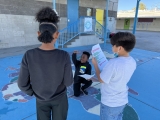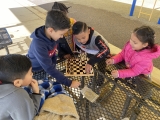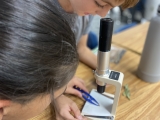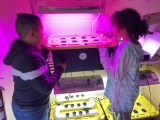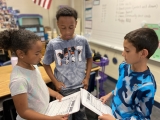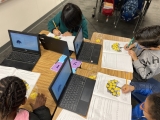-
Category 1
Selected in 2023
-
Grades: k - 5
School Setting: urban
Town Population: 2,227,053
Student Enrollment: 520
Student Demographics:
Black/African American: 16%
Teacher/Student Ratio: 1:22.5
White/Caucasian: 10.1%
Hispanic: 63.8%
Hawaiian/Pacific Islander: 0.6%
Asian: 3.5%
Native American: 0%
Other: 6%
% Reduced Lunch: 80.4%
% ELL Learners: 25.4%
Founded: 1962 -
PRINCIPAL:
Stanica Sretenovic -
CONTACT:
1200 N. 27th Street
Las Vegas, NV 89101
702-799-7095
sretes@nv.ccsd.net
Walter Bracken STEAM Academy
Las Vegas, NV
Collaboration is the driving force behind positive change at Walter Bracken STEAM Academy.
- 1. Tell us about your school’s success.
-
We developed a comprehensive improvement plan with goals for proficiency rate increases. Data from common assessments and progress monitoring is used to develop and implement the strategies that support student achievement and growth. Teachers collaborate to analyze common assessment data, enabling differentiated instruction and targeted scaffolding. Flexible math and reading groups address individual needs, supported by digital curriculum pathways. Students actively engage in goal setting, tracking, and an incentive program aimed at fostering intrinsic motivation. Family involvement includes sharing data and strategies for home support. Teachers have focused on unwrapping content standards and implementing cooperative learning strategies, the components of an effective lesson, and math curriculum alignment. Student attendance is promoted through strategically scheduled school activities and incentives.
- 2. Talk about the greatest contributing factor(s) that promoted positive change in your school.
- Collaboration is the driving force behind positive change at Walter Bracken STEAM Academy. Staff, students, and families working together toward common goals has fostered an environment of innovation and progress. Learning walks and book studies have enriched staff expertise, improving planning, instruction, and assessment practices. Strategic planning with the development of a 5-year plan, has allowed for manageable steps and timelines, ensuring stakeholder buy-in. Identifying areas for improvement and establishing a roadmap has resulted in sustained positive changes. Protecting collaboration meetings has kept teacher growth at the forefront. Questioning existing methods and fostering a culture of inquiry has led to the replacement of outdated practices with more student-centered approaches. This combination of collaboration, strategic planning, and understanding the rationale behind practices has created a culture of positive change at Walter Bracken STEAM Academy.
- 3. How has ESEA funding supported the school's success?
- Funding supports strategist roles focusing on math, reading, and STEAM. The strategists aid teachers with classroom management, lesson effectiveness, and curriculum use. They worked to develop PLC practices, unwrap standards, create learning progressions, and design assessments. They mentor teachers in instruction and parent communication. They identify students needing academic support and provide targeted interventions. The strategists support the MTSS structure with data impact meetings to analyze student data and revise growth plans. They conduct PD sessions on curriculum, digital programs, and assessment tools, tailored to teachers' needs. Funding has enabled a comprehensive approach to improve teaching practices and student outcomes. The STEAM strategist focuses on organizing science materials, collaborating with teachers to create hands-on lessons, ensuring efficient storage solutions, promoting easy access for lab activities and fostering a positive STEAM learning environment.
- 4. What professional development activities were used to improve teaching and learning?
- Staff engages in ongoing professional development, focusing on three key areas: enhancing stakeholder engagement with the magnet program, improving tier one literacy and STEAM integration, and refining student goal setting for ownership and choice in learning. A workshop through Magnet Schools of America deepened staff understanding of magnet school principles, guiding them to redesign the first day of school to align with the STEAM theme and involve families. Open House enhancements showcase innovative practices and curriculum. Professional development supports integrating STEAM with literacy, addressing academic needs, and closing the achievement gap through student goal setting and incentives. Staff also learns effective PLC facilitation, unwrapping learning intentions, discussing STEAM integration, and developing best practices. Regular attendance at the Magnet Schools of America National Conference further enriches professional development centered on magnet schools.
- 5. Talk about the cultural shift leading up to your school's success.
- Staff collaboratively crafted a 5-year growth plan, focusing on climate and culture as key areas. Recognizing misalignment, we reimagined mission and vision statements through community input, emphasizing 21st-century skills. Educational programming prioritizes communication and collaboration, integrating the gradual release model and structured student collaboration. Stakeholder collaboration fosters teamwork, strengthening family engagement and creating a welcoming school atmosphere. Family events were redesigned, enhancing connections and celebrating successes together. The culture shift resulted in increased family involvement and awareness of educational goals. Embracing a growth mindset, staff is encouraged to fail forward, supported by continuous professional development. Data-informed decision-making extends from staff decisions to instructional choices, promoting shared responsibility for success. This cultural transformation has significantly contributed to our achievements.
- 6. How has community involvement strengthened your success?
- Our approach to involvement centers on leveraging community diversity, celebrating differences, and fostering respectful communication. Respect-based relationships empower families to share and listen to viewpoints. Events are translated for non-English speakers, and technology education ensures equal access for families of diverse backgrounds. We engage families in their children's achievements by sharing benchmark data and student goals. Partnerships with organizations like the Rotary Club, Raiders, Vegas Golden Knights, Green Our Planet, Navarro Research and Engineering, and Get Outdoors Nevada provide STEAM opportunities. These partners support our broadcasting program, hydroponics lab, coding instruction, and field research. Families participate in decision-making processes, contributing to our School Performance Plan and budget. This collaborative approach ensures diversity is embraced and celebrated throughout our school community.
Stats
-
Category 1
Selected in 2023
-
Grades: k - 5
School Setting: urban
Town Population: 2,227,053
Student Enrollment: 520
Student Demographics:
Black/African American: 16%
Teacher/Student Ratio: 1:22.5
White/Caucasian: 10.1%
Hispanic: 63.8%
Hawaiian/Pacific Islander: 0.6%
Asian: 3.5%
Native American: 0%
Other: 6%
% Reduced Lunch: 80.4%
% ELL Learners: 25.4%
Founded: 1962 -
PRINCIPAL:
Stanica Sretenovic -
CONTACT:
1200 N. 27th Street
Las Vegas, NV 89101
702-799-7095
sretes@nv.ccsd.net


